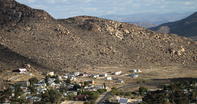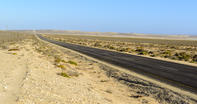Getting Ore to the Shore
Transporting the copper in Namaqualand from the mines to the coast was not only difficult, it was expensive. By 1855, the cost of getting ore to the shore equalled the total cost of mining the stuff in the first place.

The figures broke down like this: copper riders were paid £7 10s to travel to the coast, and £3 to return back to the mines; shipping to Table Bay cost £1 10s; shipping to London cost between £2 and £3; transport from London to the smelting works at Swansea cost a mere 10s or 15s; amounting to a total cost of £16 pounds per ton (£10 of which was for the short overland route of 120 km).
These high prices meant that only the highest grade ore could be profitably exported, while hundreds of tons of lower grade ore were stockpiled at the mines. Furthermore, the riding season was limited to the wet winter months, when there was enough water for the draught animals, so transportation of ore was sporadic. The mines made repeated calls for improved roads or, even better, a railway that would make transport more efficient.
However, the government didn’t want to pay for the construction of proper roads, as they believed the mines were making a decent profit as things stood. The mine owners, for their part, felt that their leases were too short to justify spending large amounts of money on infrastructure and, in any case, they were generally low on capital and high on speculation. It was a stalemate.
Refused to Budge

In an attempt to settle the issue, two Select Committees were set up (in 1854 and 1855). Both committees considered the development of the mines in Namaqualand to be of national importance, and both recommended the construction of railway line from Hondeklip Bay across the Sandveld, as this would facilitate a cost-effective bulk transportation system that would unlock the value of the lower-grade ores.
The government refused to budge, despite the sage advice of respected surveyors A.G. Bain and Charles Bell. There were some suggestions of floating a railway consortium, which would construct the railway as a profit-making exercise, but this didn’t materialise because, just at that moment, the copper boom went bust and no-one was prepared to invest.
The two remaining copper companies (Phillips and King and the Namaqua Mining Company) were left to their own devices. Phillips and King, the larger of the two, took it upon themselves to repair the road to Hondeklip Bay at their own expense after each riding season, but the road seemed to deteriorate year to year. Various government agents protested that this wasn’t fair, as the mines brought a lot of money into the colony, but nothing was done.
The Status Quo
To compensate themselves, Phillips and King quietly bought up almost all the farms along the route from Springbok to Hondeklip Bay. This left their rivals in a tenuous position, but the Namaqua Company did manage to secure their own outspan on one of the farms along the way. They also sent their wagons to Port Nolloth, when the erratic water supply would allow.
Things proceeded in this manner until 1862, when another Select Committee was appointed to investigate the construction of a road, which they soon recommended. The committee also considered an application from Phillips and King (now called the Cape Copper Company) who wanted to construct a railway line from Hondeklip Bay to Riethuis Farm, 16 miles away.
This section of track would eliminate the difficult stretch across the Sandveld, and the committee agreed to the proposal on condition that public goods would be transported and that the line be sold back to the govt at cost after 10 years. But the funds were still not forthcoming and the status quo was maintained.
By David Fleminger